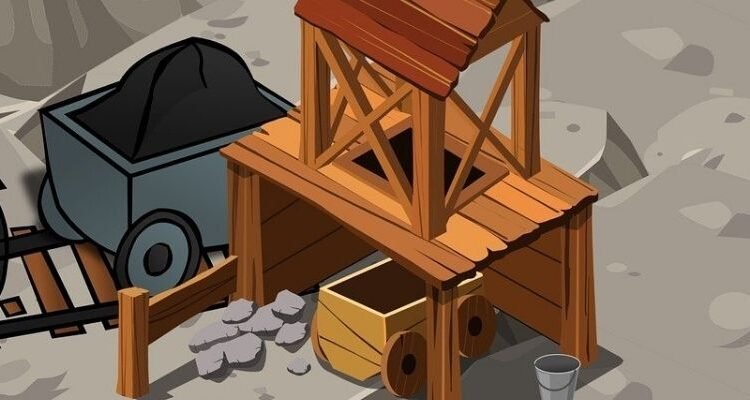You might think that mining claims are a thing of the past, but they still play a significant role in the exploration and extraction of minerals today.
Let’s unlock their secrets!
1. Background of Mining Claims
The concept of mining claims has roots that stretch back centuries, reflecting the fundamental human interest in discovering and extracting valuable minerals from the earth.
In the United States, the history of mining claims can be traced back to the famous Gold Rush era of the mid-19th century.
Miners needed legal means to lay claim to particular plots of land for exploration, and this gave birth to an organized system of mining claims.
Over time, as mineral discovery and extraction became more sophisticated, so did the legal frameworks surrounding mining claims.
These have evolved to accommodate different types of minerals and various methods of mining.
Countries across the globe have established their unique sets of rules and regulations, aligning with both domestic interests and international standards.
Today, mining claims continue to be an integral part of the mining industry, acting as the bridge between exploration and production.
The process ensures that rights to explore, extract, and sell minerals are well-defined, providing a clear pathway for miners and contributing to a fair and responsible utilization of natural resources.
2. Legal Aspects of Mining Claims
The legal facets of mining claims are multifaceted, encompassing various types of claims, as well as the procedures for filing and maintaining them.
Understanding these aspects is key to successful exploration and extraction of minerals.
Types of Mining Claims
Lode and placer claims are the primary categories of mining claims, and their distinction lies in the type of mineral deposits they pertain to.
![]()
![]() Lode Claims: These claims are associated with mineral deposits found in rock formations, typically occurring in veins.
Lode Claims: These claims are associated with mineral deposits found in rock formations, typically occurring in veins.
Lode claims grant miners the rights to mine valuable minerals embedded within these veins.
![]()
![]() Placer Claims: Unlike lode claims, placer claims pertain to loose or alluvial minerals found near the surface, usually in riverbeds or other water-deposited areas.
Placer Claims: Unlike lode claims, placer claims pertain to loose or alluvial minerals found near the surface, usually in riverbeds or other water-deposited areas.
Gold panning is a familiar example of mining that would require a placer claim.
Understanding the difference between these two types of claims is vital, as it affects both the legal rights and the techniques used in extraction.
Mill sites and tunnel sites can also be established to furnish support facilities for both lode and placer mining claims.
![]()
![]() Mill Sites: These are specific areas of non-mineral land used for mining-related activities, such as processing ore.
Mill Sites: These are specific areas of non-mineral land used for mining-related activities, such as processing ore.
Mill sites support the actual extraction happening under a lode or placer claim, providing space for necessary facilities.
![]()
![]() Tunnel Sites: Tunnel sites are claims on a vein or lode with a known location.
Tunnel Sites: Tunnel sites are claims on a vein or lode with a known location.
They allow for the excavation of a tunnel to access the valuable minerals.
The right to a tunnel site requires distinct legal documentation and carries its specific set of rights and regulations.
Filing and Maintaining a Mining Claim
Staking a mining claim is a legal procedure that establishes a miner’s right to extract minerals from a specific plot of land.
The process includes:
![]()
![]() Locating: Identifying a site where locatable minerals exist.
Locating: Identifying a site where locatable minerals exist.
![]()
![]() Recording: Filing the necessary paperwork with the appropriate government office to legally record the claim.
Recording: Filing the necessary paperwork with the appropriate government office to legally record the claim.
![]()
![]() Marking: Physically marking the boundaries of the claim on the land, often with posts or other recognizable markers.
Marking: Physically marking the boundaries of the claim on the land, often with posts or other recognizable markers.
![]()
![]() Fees and Documentation: Paying the required fees and submitting all relevant documents to ensure compliance with legal regulations.
Fees and Documentation: Paying the required fees and submitting all relevant documents to ensure compliance with legal regulations.
Once a mining claim is staked, there are ongoing obligations to meet.
These often include:
![]()
![]() Payment of Fees: Regular payment of fees is required to keep the claim in good standing.
Payment of Fees: Regular payment of fees is required to keep the claim in good standing.
![]()
![]() Fulfillment of Work Commitments: Many jurisdictions require claimants to perform a certain amount of work on the claim each year.
Fulfillment of Work Commitments: Many jurisdictions require claimants to perform a certain amount of work on the claim each year.
![]()
![]() Compliance with Environmental Regulations: Meeting all environmental guidelines and regulations is an ongoing requirement to prevent harmful impacts on the surrounding ecosystem.
Compliance with Environmental Regulations: Meeting all environmental guidelines and regulations is an ongoing requirement to prevent harmful impacts on the surrounding ecosystem.
Failure to meet these annual maintenance requirements can result in the loss of the claim.
Therefore, understanding and complying with all legal aspects of mining claims is fundamental to securing and maintaining the rights to explore and extract valuable mineral resources.
This comprehensive legal framework ensures responsible mining practices and clear ownership rights, contributing to the integrity and efficiency of the mining industry as a whole.
3. Economic and Environmental Impact
The interaction between mining activities and both economic and environmental spheres is intricate and multifaceted.
These aspects form a crucial part of the discourse surrounding mining claims, reflecting the balance that must be maintained between economic progress and ecological stewardship.
![]()
![]() Contributions to Local and National Economies
Contributions to Local and National Economies
Mining activities are a driving force in many economies, influencing various sectors, from industry to services.
The extraction of valuable minerals like gold, silver, copper, and more contributes significantly to government coffers.
These revenues come from taxation, royalties, and other fiscal tools applied to mining operations.
Beyond governmental revenue, mining also grows the income of corporations and local communities.
The financial inflow from mining claims can lead to investment in infrastructure, education, and other essential community services.
Not to mention that mining claims lead to the creation of numerous jobs, both direct and indirect.
Direct employment encompasses those working within the mining sites, such as miners, engineers, geologists, and administrators.
Indirectly, mining stimulates other sectors of the economy, including manufacturing, transportation, and services, creating a ripple effect of employment across various industries.
These opportunities often breathe life into local communities, offering avenues for livelihood and growth.
![]()
![]() Environmental Considerations
Environmental Considerations
Mining’s relationship with the environment is complex, reflecting both the potential benefits of resource extraction and the need to preserve ecological balance.
Modern mining practices are governed by a framework of laws and regulations aimed at minimizing environmental harm.
These laws enforce best practices in areas like waste disposal, water usage, air quality, and land reclamation.
The objective is to strike a balance that allows for mineral extraction without significant ecological degradation.
Compliance with these regulations is not only a legal obligation but also often serves as an indicator of a mining company’s commitment to responsible practices.
In regions rich with both mineral resources and unique ecosystems, mining claims can create conflicts between conservation goals and economic interests.
These conflicts arise when mining activities are proposed or conducted in areas with endangered species, pristine landscapes, or other ecologically sensitive attributes.
Such conflicts require careful consideration and negotiation, often involving various stakeholders such as governmental bodies, conservation organizations, mining companies, and local communities.
The resolution of these issues involves evaluating the potential economic benefits against the value of preserving the natural environment.
In some cases, solutions are found through mitigation strategies, like creating offset conservation areas or employing environmentally friendly mining techniques.
However, these conflicts can also lead to prolonged legal battles or even the abandonment of mining activities in favor of conservation.
4. Contemporary Trends and Challenges
In a world where the demand for resources continues to grow, mining activities adapt to ever-changing technological, political, and global contexts.
The contemporary landscape of mining claims sees trends and challenges that intertwine, reflecting the sector’s drive for innovation and the complex realities it faces.
Here’s how these aspects are playing out in today’s mining industry:
![]()
![]() Technological Advancements
Technological Advancements
The face of mining has changed dramatically in recent years, thanks to the rise of modern technologies.
Automation, data analytics, and other cutting-edge tools have allowed mining companies to operate more efficiently and safely.
These innovations are not only boosting productivity but also mitigating the risks traditionally associated with mining.
Advanced exploration technologies facilitate the discovery of new deposits, while improved extraction methods are reducing the environmental footprint.
And the emphasis on sustainability is becoming increasingly pronounced in the mining sector.
Mining companies are investing in renewable energy sources, water management systems, and waste reduction technologies.
These initiatives are aimed at diminishing the negative environmental impact and aligning the industry with global sustainability goals.
Collaborative efforts between governments, non-governmental organizations, and the private sector are creating a broader shift toward responsible mining practices.
![]()
![]() Political and Social Debates
Political and Social Debates
The mining industry often finds itself at the intersection of political and social debates, reflecting broader societal values and interests.
Foreign Ownership Issues: The control of valuable mining assets by foreign entities has led to debates and concerns in various countries.
Questions of sovereignty, economic benefit, and national security arise, leading to regulatory scrutiny and sometimes restrictions on foreign investment in mining.
Public Land Conflicts: The use of public lands for mining has created tensions and debates, particularly in the United States.
For example, in 2023, the proposed Bureau of Land Management rule, which seeks to regulate mining activities on federal lands, has been a flashpoint for contention.
Different stakeholders, from environmental groups to industry leaders, are engaged in arguments over the rights, responsibilities, and limitations related to mining on public lands.
![]()
![]() International Perspectives
International Perspectives
As the mining industry operates globally, understanding international perspectives is vital.
The U.S. mining industry, with its unique legal framework and market dynamics, often contrasts with mining practices in other countries.
Regulatory environments, labor conditions, environmental standards, and community engagement vary widely across the globe.
These differences can create both opportunities and challenges for companies operating internationally.
The global community is also working toward shared objectives, such as the United Nations’ Sustainable Development Goals, which impact mining practices.
International agreements and collaborative efforts are shaping the future of mining, emphasizing responsible resource extraction, and aligning practices across borders.
5. Practical Information About Mining Claims
The complexities of mining claims extend far beyond the geological aspects of mineral deposits.
Stakeholders, from claimants to investors and governmental authorities, must be aware of various legal and practical dimensions.
The process of asserting and utilizing mineral rights, coupled with the know-how required to stake a claim successfully, demands careful attention and expertise.
Here’s what stakeholders need to know:
![]()
![]() Understanding Mineral Rights
Understanding Mineral Rights
Mineral rights can be a complex legal matter.
Determining ownership involves researching land deeds, consulting public records, and understanding local, state, or federal laws that might apply.
It may necessitate engaging legal or real estate professionals who specialize in mining and mineral rights.
It’s not uncommon for surface rights and mineral rights to be separate; thus, understanding these distinctions is fundamental in the ownership ascertainment process.
Depending on the circumstances and intentions of the stakeholders, leasing or purchasing mineral rights may be more suitable.
Leasing provides an option to explore and develop the land for a fixed term, often with provisions for royalty payments to the landowner.
Purchasing rights, on the other hand, provide full control over the mineral resources, although this typically involves more significant upfront costs and long-term responsibilities.
The decision between leasing and purchasing requires careful consideration of factors such as investment capacity, risk tolerance, and long-term strategic goals.
![]()
![]() Expert Tips for Potential Claimants
Expert Tips for Potential Claimants
Mining claims, with their intrinsic complexities, require insightful knowledge and understanding.
Below are some well-crafted guidelines tailored for potential claimants:
Best Practices:
![]()
![]() Conduct Thorough Research: Investigate the legal status, geological aspects, and any historical data associated with the land before staking a claim.
Conduct Thorough Research: Investigate the legal status, geological aspects, and any historical data associated with the land before staking a claim.
![]()
![]() Understand Local Regulations: Familiarize yourself with the laws and requirements specific to the jurisdiction in which you’re staking the claim.
Understand Local Regulations: Familiarize yourself with the laws and requirements specific to the jurisdiction in which you’re staking the claim.
![]()
![]() Engage Professional Assistance: Consider employing legal, geological, or mining professionals to ensure compliance with all aspects of the process.
Engage Professional Assistance: Consider employing legal, geological, or mining professionals to ensure compliance with all aspects of the process.
![]()
![]() Develop a Responsible Mining Plan: Outline a clear and sustainable plan that considers both economic viability and environmental stewardship.
Develop a Responsible Mining Plan: Outline a clear and sustainable plan that considers both economic viability and environmental stewardship.
![]()
![]() Build Relationships with Local Communities: Engage with local authorities and communities early to establish trust and mitigate potential conflicts.
Build Relationships with Local Communities: Engage with local authorities and communities early to establish trust and mitigate potential conflicts.
Avoiding Common Pitfalls:
![]()
![]() Avoid Overlapping Claims: Thoroughly check existing mining claims to prevent legal disputes over the same area.
Avoid Overlapping Claims: Thoroughly check existing mining claims to prevent legal disputes over the same area.
![]()
![]() Don’t Neglect Environmental Regulations: Comply with all relevant environmental laws to avoid fines, legal action, or reputation damage.
Don’t Neglect Environmental Regulations: Comply with all relevant environmental laws to avoid fines, legal action, or reputation damage.
![]()
![]() Beware of Incomplete Documentation: Ensure all paperwork, such as maps and legal descriptions, is complete and accurate to avoid potential legal challenges.
Beware of Incomplete Documentation: Ensure all paperwork, such as maps and legal descriptions, is complete and accurate to avoid potential legal challenges.
![]()
![]() Stay Abreast of Renewal Deadlines: Missing deadlines for claim renewal can lead to a forfeiture of rights; thus, maintaining a clear schedule is vital.
Stay Abreast of Renewal Deadlines: Missing deadlines for claim renewal can lead to a forfeiture of rights; thus, maintaining a clear schedule is vital.
![]()
![]() Avoid Poor Communication: Miscommunication with stakeholders, including government authorities or local communities, can lead to misunderstandings and conflicts.
Avoid Poor Communication: Miscommunication with stakeholders, including government authorities or local communities, can lead to misunderstandings and conflicts.
Clear and transparent communication is key.
Conclusion
In summary, the ever-changing regulatory environment and evolving industry practices highlight the need for continuous vigilance and adaptability.
Potential future modifications to laws or industry methods may redefine how mining claims are managed.
Staying informed, understanding the implications, and engaging proactively with this subject will position individuals and organizations for success in the intricate and influential sphere of mining claims.
FAQs
![]()
![]() How can one ensure compliance with the annual maintenance requirements of a mining claim?
How can one ensure compliance with the annual maintenance requirements of a mining claim?
Ensuring compliance requires adhering to regulations set by local authorities, which may include filing specific documents and paying required fees.
It’s advisable to consult with a legal expert familiar with mining laws in the jurisdiction.
![]()
![]() Are there specific practices to follow for foreign ownership of mining claims in the U.S.?
Are there specific practices to follow for foreign ownership of mining claims in the U.S.?
Foreign ownership may be subject to additional regulations and scrutiny.
Legal consultation with an expert in international mining laws is recommended to navigate country-specific requirements and ensure compliance with U.S. federal and state laws.
Would you like to receive weekly emails with our latest blog/properties?


Disclaimer: we are not lawyers, accountants or financial advisors and the information in this article is for informational purposes only. This article is based on our own research and experience and we do our best to keep it accurate and up-to-date, but it may contain errors. Please be sure to consult a legal or financial professional before making any investment decisions.








Recent Comments